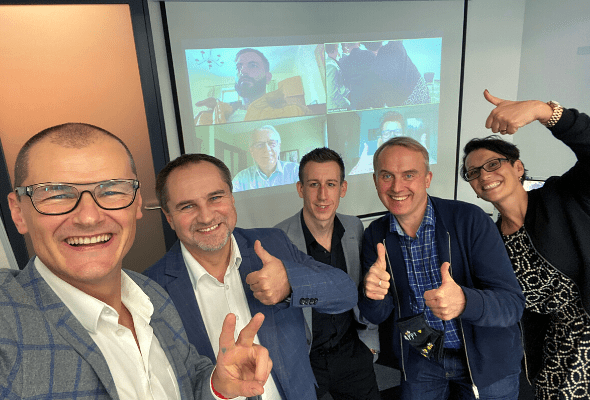
Coaching in the organization is slowly becoming an integral part of the development of an individual and the entire organization. Altogether, more and more presidents, directors and managers decide on coaching processes to accelerate their development. And also, increase their effectiveness and achieve their intended goals more effectively. Coaching supports the development of leadership in the organization. Therefore, the best results are achieved by implementing it throughout the enterprise. When this form of support was „in its infancy” in Poland and was just beginning to arouse interest.
The services of external coaches were not fully regulated. Neither coaches nor organizations paid attention to quality control of coaching and calculating the return on investment from coaching. Adding on, understanding the operational environment of the organization by coach. Also, measuring the existing situation before and after the coaching process. Coaching was not always implemented positively within organizations. This is because coaches did not know what the process itself was and how to properly evaluate it. Over time, the companies that developed the fastest were those that introduced coaching into the culture of the entire organization. Also, effectively use it as a process to support lasting changes.
Coaching is a key element of leadership development programs. As the largest companies know and use it to develop the most important leaders of the organization. This is a disruptive phenomenon that is changing the way people work together. Coaching introduced to the entire organization improves its efficiency, results and cooperation between employees. A strong coaching culture offers support in almost every area within the company. So how can you, as an entrepreneur, CEO or HR director, successfully implement such a coaching culture in your organization to fully benefit from all its benefits?
Based on cooperation with our clients, where we implemented coaching throughout the organization. We have created a list of 7 steps on how to start and where to end so that coaching brings long-term growth for the entire organization. Also, ensuring incredibly efficient, effective and inspiring leaders, to those employees who need support in change or development. Here are 7 key point:
1. Conduct a coaching culture assessment
To be able to build a world-class coaching culture in an organization, you must start with its rigorous assessment. This will reveal current strengths and potential opportunities. Furthermore, this can be leveraged to address the challenges of developing a coaching culture. As part of such an assessment, it will be necessary to interview all people making key decisions in the company. Thanks to this, you will determine what changes are most needed now. ie. Whether coaching is already being used effectively and how it is received or how effective coaches are currently. Moreover, whose services you use and what key competencies your organization should develop in the coming years. While current coaching in the organization works reasonably well, a coach should help you prepare a personalized program that will help you and the company achieve all your goals and develop great leaders.
2. Don’t be afraid of changes
Think about whether you have people in your company who are afraid of changes? Many people may perceive change as painful, even unacceptable, because it most often requires leaving their comfort zone. Coaching is often rejected for „reasons” such as lack of time to implement it in the company. Also, lack of interest in coaching by managers, or lack of budget. You can counter this resistance to change by getting curious about what’s behind it. In addition, encouraging all employees to talk openly about their fears. Invite everyone to fully engage in the change process. When participants of such a change learn the power of coaching, their fear will begin to lessen and they will begin to feel appreciated.
3. Choose the right team of external coaches

Research shows that approximately 35% of new CEOs and directors fail within 18 months of taking up their new job. This because many of them admit that they did not know how to get support in their new role. Executive coaches and business coaches have the appropriate tools that help a director or manager effectively assume the position. Setting defined goals that the client and the coach agree upon is the first step in the highly results-oriented process of coaching. For everything to go as planned, you need to set up the standards which you will choose an exceptional team of coaches. Therefore, they will collaborate with top leaders at the start of the process. When choosing, pay attention to credibility, cultural awareness and emotional intelligence. Above all, the experience of people who will effectively support your business and help it move to the next level.
4. Take care of the development of internal coaches
Coaching implemented into the entire organizational culture is best started with cooperation with a group of external coaches. However, after some time, when coaching begins to reach subsequent, lower levels of organizational structures. It is worth analyzing the development of internal coaches employed in the organization. You can offer this role to the most outstanding leaders and talents in the organization. Moreover, this will bind them even closer to the company. Thanks to internal coaches, the company can save money and have greater flexibility and benefits for employees. Some leaders and managers will prefer to work with external coaches, and some with internal ones. At this stage, it is worth training internal coaches well, preparing a dedicated program within the organization or sending them to an external coaching school.
In this case, a dedicated program within the organization is much better than working with an external coaching school. The organization may simply place some emphasis on developing certain solutions or work methods of coaches that are specific to it. A clear benefit of implementing coaching at this stage will be that employees using coaching services are more likely to stay with the service. In the case of senior leaders, when they are more willing to use the services of external executive coaches. Therefore, the model in which internal coaches work with managers and lower-level employees. Lastly, presidents and directors work with external executive coaches, works best.
5. Expand your leadership skills
Leaders who receive coaching support are more likely to be promoted, maintain work-life balance, and can prepare the next leaders. In addition to improving leadership skills, coaching also influences the way you conduct meetings, organize your time, and interact in everyday conversations with other employees. When team members learn to coach each other, they develop very deep bonds. Coaching provides the foundation for creating strong relationships throughout the organization. When an organization invests in people, they feel appreciated. Hostility, distrust and burnout disappear when coaches work together to build balanced leaders in every department in the company.

6. Adapt policies and procedures
Creating a coaching culture in a company is much more than just encouraging people to develop themselves and improving organizational effectiveness. To ensure the development of a coaching culture, it is crucial to review policies within the company. Which of your company’s HR policies already support a respectful, energetic coaching culture, and which need to be reviewed? Find out what support managers need to provide inspiring feedback to the rest of their employees, share knowledge and increase active engagement in the company. How does your reward system support coaching and collaboration rather than internal competition among employees? What policies within the company ensure that people at all levels have access to coaching and development opportunities? Analysis of all these aspects leads to effective implementation and maintenance of the coaching culture in the organization for many years.
7. Evaluate your coaching program and measure results
This is the last step to effectively implementing a coaching culture in your company. Now consider how much you currently spend or potentially are willing to spend on coaching. Also, what return on investment you have or will have. Investment in coaching is growing across businesses, but few organizations objectively evaluate the coaching process or determine the return on investment. Be sure to read our article“Coaching with ROI” . We explain exactly what criteria you should use when assessing the return on investment. To assess whether the organization has created the desired coaching culture and achieved the desired goals. You need to adapt the indicators individually to the company. These may include indicators such as:
- leadership development – looking at the increase in promotions in the company
- building relationships – increasing the number of company recommendations and references, improving the atmosphere among employees
- employee involvement – reduction of employee turnover and reduction of absenteeism and complaints

A good coaching program should include methods for assessing the progress of coaching implementation.
We invite you to a free consulting session and discuss your challenges related to the development of yourself, your teams and your organization. Therefore, Make an appointment in the calendar or write to us atinfo@PerfectCircle.pl. Customer success is our passion – let us help you develop your company effectively!
¹ Hitch, Chris, “How to Help Executive Leaders Succeed,” www.kenan-flagler.unc.edu/execdev/

